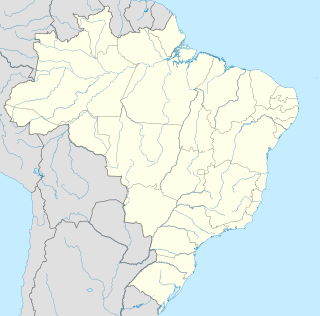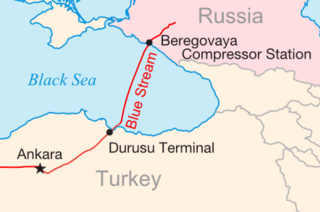
Blue Stream is a major trans-Black Sea gas pipeline that carries natural gas from Russia into Turkey. The pipeline has been constructed by the Blue Stream Pipeline B.V., the Netherlands based joint venture of Russian Gazprom and Italian Eni. The Blue Stream Pipeline B.V. is an owner of the subsea section of pipeline, including Beregovaya compressor station, while Gazprom owns and operates the Russian land section of the pipeline and the Turkish land section is owned and operated by the Turkish energy company BOTAŞ. According to Gazprom the pipeline was built with the intent of diversifying Russian gas delivery routes to Turkey and avoiding third countries.

The Yamal–Europe natural gas pipeline is a 4,196 kilometres (2,607 mi) long pipeline connecting natural gas fields in Western Siberia and in the future on the Yamal peninsula, Russia, with Germany.
The Baltic Gas Interconnector was a project of the natural gas submarine pipeline between Germany, Denmark and Sweden. The pipeline would connect the existing pipeline networks of southern Scandinavian and Continental European countries in order to secure uninterrupted supply of natural gas.
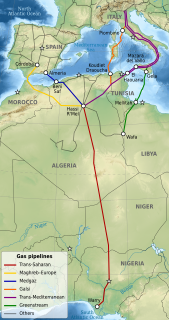
Medgaz is a submarine natural gas pipeline between Algeria and Spain.

The Trans-Mediterranean Pipeline is a natural gas pipeline from Algeria via Tunisia to Sicily and thence to mainland Italy. An extension of the TransMed pipeline delivers Algerian gas to Slovenia.
The West–East Gas Pipeline is a set of natural gas pipelines which run from the western part of China to the east.
The West African Gas Pipeline (WAGP) is a natural gas pipeline to supply gas from Nigeria's Escravos region of Niger Delta area to Benin, Togo and Ghana. It is the first regional natural gas transmission system in sub-Saharan Africa.
The Eastern Siberia–Pacific Ocean oil pipeline is a pipeline system for exporting Russian crude oil to the Asia-Pacific markets. The pipeline is built and operated by Russian pipeline company Transneft.

The Central Asia – Center gas pipeline system is a Gazprom controlled system of natural gas pipelines, which run from Turkmenistan via Uzbekistan and Kazakhstan to Russia. The eastern branch includes the Central Asia - Center (CAC) 1, 2, 4 and 5 pipelines, which start from the south-eastern gas fields of Turkmenistan. The western branch consists of the CAC-3 pipeline and a project to build a new parallel Caspian pipeline. The western branch runs from the Caspian Sea coast of Turkmenistan to north. The branches meet in western Kazakhstan. From there the pipelines run to north where they are connected to the Russian natural gas pipeline system.
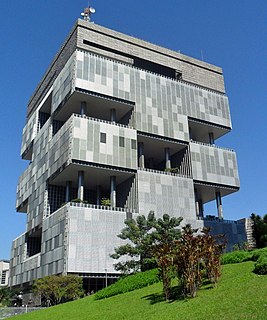
Brazil is the 10th largest energy consumer in the world and the largest in South America. It is an important oil and gas producer in the region and the world's second largest ethanol fuel producer. The government agencies responsible for energy policy are the Ministry of Mines and Energy (MME), the National Council for Energy Policy (CNPE), the National Agency of Petroleum, Natural Gas and Biofuels (ANP) and the National Agency of Electricity (ANEEL). State-owned companies Petrobras and Eletrobrás are the major players in Brazil's energy sector, as well as Latin America's.

The Gran Gasoducto del Sur was a proposed 8,000–15,000-kilometer (5,000–9,300 mi) long natural gas pipeline to connect Venezuela, Brazil and Argentina. The overall project cost was expected to be around US$17-23 billion.
Paraná-Uruguayana pipeline is a natural gas pipeline from Aldea Brasilera, Paraná in Argentina to Uruguaiana in Brazil.
The Bolivia–Brazil pipeline (GASBOL) is the longest natural gas pipeline in South America. The 3,150 kilometres (1,960 mi) pipeline connects Bolivia's gas sources with the south-east regions of Brazil.
The Urucu–Manaus pipeline is a natural gas pipeline in Brazil. It allows use of the natural gas from Urucu, which is the largest onshore natural gas reserve in Brazil. The gas is used to substitute diesel and fuel oil for the electricity production in the state of Amazonas, and the pipeline supplies cities of Coari, Codajás, Anori, Anamã, Caapiranga, Manacapuru, Iranduba, and Manaus. The pipeline was inaugurated on 26 November 2009, and it is operated by Transportadora Urucu-Manaus S.A., a subsidiary of Petrobras.
The Dolphin Gas Project is the natural gas project of the Qatar, United Arab Emirates, and Oman. It is the Gulf Cooperation Council's first cross-border refined gas transmission project and the largest energy-related venture ever undertaken in the region.
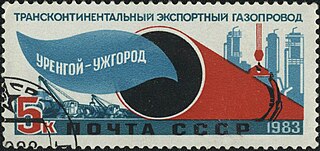
The Urengoy–Pomary–Uzhhorod pipeline is one of Russia's main natural gas export pipelines, partially owned and operated by Ukraine.
Sichuan–Shanghai gas pipeline is a 1,702 kilometres (1,058 mi) long natural gas pipeline in China. The pipeline runs from Pugang gas field in Dazhou, Sichuan Province, to Qingpu District of Shanghai. An 842 kilometres (523 mi) long branch line connects Yichang in Hubei with Puyang in Henan Province. Two shorter branches are located near the Puguang gas field and one in the east near Shanghai.
The Rockies Express Pipeline is a 1,679-mile (2,702 km) long high-pressure natural gas pipeline system from the Rocky Mountains of Colorado to eastern Ohio. The pipeline system consists of three sections running through eight states. It is one of the largest natural gas pipelines ever built in North America.
Gryazovets–Vyborg gas pipeline is a branch pipeline of the Northern Lights pipeline from Gryazovets in central part of Russian Federation through Vologda and Leningrad oblasts to Saint Petersburg, Vyborg, and Finland. The third line of this pipeline was built to feed the Nord Stream pipeline.
Persian Pipeline, also known as the Pars Pipeline and Iran–Europe pipeline, is a proposed natural gas pipeline to transfer Iranian gas from the Persian Gulf to European markets.




